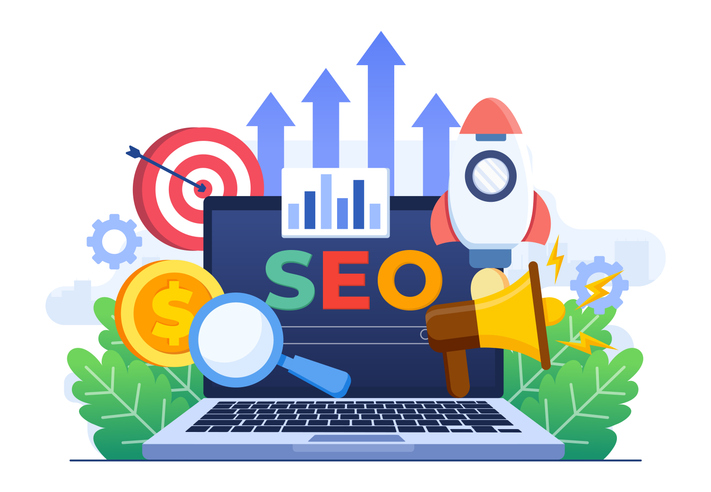4 min read
5 min read
Mastering Local SEO Strategies for Higher Rankings
![]() The Amazing Team at Focus Digital Marketing
:
May 28, 2024 10:00:00 AM
The Amazing Team at Focus Digital Marketing
:
May 28, 2024 10:00:00 AM
Digital marketing is an ever-evolving strategy that businesses around the world are adopting to stay relevant in today's digitally-driven world. In the United States, digital marketing has become an integral part of many businesses' overall marketing strategies. This comprehensive article will delve into the definition, key components, implementation steps, benefits, challenges, analytics report, case studies, and future trends of digital marketing in the USA.
Definition:
Digital marketing can be defined as the use of digital channels and tactics to promote and advertise products, services, and brands. It involves leveraging various digital platforms such as websites, search engines, social media, email, and mobile apps to reach and engage with target audiences.
Key Components:
There are several key components of digital marketing that businesses in the USA need to consider. These include:
1. Website Optimization: A well-designed and user-friendly website is crucial for any digital marketing strategy. It should be optimized for search engines to ensure higher rankings in search results and attract organic traffic.
2. Search Engine Optimization (SEO): SEO involves optimizing the website's content, structure, and design to improve its visibility in search engine results. By targeting relevant keywords, businesses can increase their organic search traffic and reach potential customers.
3. Content Marketing: Content is at the heart of digital marketing. Publishing relevant and valuable content on blogs, websites, social media, and other channels helps businesses attract, engage, and retain customers.
4. Social Media Marketing: With the majority of Americans actively using social media platforms, businesses can leverage these platforms to reach and engage with their target audience. Strategies can include organic posts, paid advertisements, influencer partnerships, and community management.
5. Email Marketing: Email marketing is an effective way to communicate directly with customers. Businesses can use personalized and targeted email campaigns to nurture leads, promote products or services, and build customer loyalty.
Implementation Steps:
Implementing a successful digital marketing strategy requires careful planning and execution. Here are some steps to consider:
1. Set Clear Goals: Define the objectives and goals of the digital marketing strategy, whether it's generating leads, increasing brand awareness, or driving sales.
2. Identify Target Audience: Understand who your target audience is and create buyer personas. This will help tailor your marketing efforts to the right audience.
3. Choose the Right Channels: Research the digital channels that your target audience frequents and prioritize them accordingly. This could include search engines, social media, email, or other platforms.
4. Plan Content Strategy: Develop a content strategy that aligns with your target audience's preferences. This could include blog posts, infographics, videos, or podcasts.
5. Execute and Analyze: Implement your digital marketing plan and continuously monitor the performance. Analyze key metrics such as website traffic, conversion rates, engagement, and ROI to optimize your strategy.
Benefits:
Digital marketing offers numerous benefits for businesses in the USA:
1. Increased Reach: With the widespread use of digital technologies, businesses can reach a much larger and global audience compared to traditional marketing methods.
2. Cost-Effectiveness: Digital marketing is often more cost-effective compared to traditional advertising methods such as print or TV. It allows businesses to reach a larger audience at a fraction of the cost.
3. Personalization: Digital marketing enables businesses to deliver personalized content and offers based on customer preferences and behavior. This helps build stronger relationships with customers.
4. Real-Time Analytics: Digital marketing provides access to real-time analytics, allowing businesses to measure and track the success of their campaigns. This data helps make informed decisions and optimize marketing strategies.
5. Improved Customer Engagement: Digital marketing platforms enable businesses to engage with customers in real-time, respond to queries, and build brand loyalty. It fosters a stronger customer-business relationship.
Challenges:
While digital marketing offers numerous benefits, there are also challenges that businesses must overcome:
1. Competition: With the increasing popularity of digital marketing, businesses are facing more competition for online visibility and customer attention.
2. Technical Expertise: Implementing and managing digital marketing strategies require technical knowledge and expertise. It can be challenging for businesses without dedicated teams or resources.
3. Evolving Algorithms: Search engine algorithms and social media algorithms are constantly changing. Businesses need to stay up to date with these changes to maintain their visibility and rankings.
4. Data Security and Privacy: With the increased use of customer data for targeting and personalization, businesses need to ensure that they comply with data protection and privacy regulations.
5. Ad Fraud and Cybersecurity: Digital marketing is susceptible to ad fraud and cybersecurity threats. Businesses need to invest in security systems and stay vigilant against online threats.
Analytics Report:
Measuring the success of digital marketing campaigns is crucial to optimizing strategies. An analytics report provides insights into key metrics such as website traffic, conversion rates, engagement, and ROI. Businesses can use tools like Google Analytics or social media analytics platforms to generate these reports and gain valuable insights into the effectiveness of their digital marketing efforts.
Case Studies:
Several companies in the USA have successfully implemented digital marketing strategies. For example, Coca-Cola's Share a Coke campaign used personalized labels with customer names and achieved a 2% increase in soft drink sales. Nike's engagement on social media platforms, especially Instagram, has led to increased brand loyalty and sales. Starbucks uses mobile app-based loyalty programs and personalized offers to drive customer engagement and repeat business.
Future Trends:
The digital marketing landscape is constantly evolving, and businesses need to stay ahead of the trends to remain competitive. Some future trends include:
1. Artificial Intelligence (AI): AI-powered chatbots and virtual assistants will enable businesses to provide personalized customer experiences and enhance engagement.
2. Voice Search Optimization: With the rise of voice-activated assistants like Siri and Alexa, businesses need to optimize their content for voice search queries.
3. Video Marketing: Video content will continue to gain popularity, and businesses need to incorporate video marketing strategies to engage with their audiences effectively.
4. Influencer Marketing: Collaborating with social media influencers will remain a significant trend, as influencers have the power to sway consumer opinions and increase brand awareness.
5. Personalization: Real-time personalized marketing experiences, tailored offers, and customized product recommendations will continue to drive digital marketing strategies.
In conclusion, digital marketing is a dynamic and essential strategy for businesses in the USA. From website optimization to content marketing, social media, and email campaigns, digital marketing offers numerous benefits. However, it also comes with its share of challenges. By analyzing key metrics, businesses can measure success and optimize their strategies. As the digital landscape continues to evolve, staying updated with trends and adopting new technologies will be crucial to businesses' success.
For more information on digital marketing strategies in the USA, visit the Focus Digital Marketing website.
Frequently Asked Questions (FAQs):
1. How much does digital marketing cost in the USA?
The cost of digital marketing in the USA varies depending on factors such as the scope of services, the size of the business, and the chosen platforms. Small businesses can start with budgets as low as a few hundred dollars per month, while larger enterprises can spend thousands or more.
2. How long does it take to see results from digital marketing?
The time it takes to see results from digital marketing varies depending on the specific strategies implemented and the competitiveness of the industry. Generally, businesses can start seeing some results within a few months, but significant traction may take six months to a year.
3. How can digital marketing benefit small businesses in the USA?
Digital marketing levels the playing field for small businesses by providing them with cost-effective marketing channels to reach a larger audience. It allows small businesses to compete with larger companies and target specific audiences.
4. Can digital marketing help increase sales for e-commerce businesses?
Yes, digital marketing is highly effective in increasing sales for e-commerce businesses. By implementing strategies such as search engine optimization, targeted advertising, and email marketing, businesses can attract more website visitors and convert them into paying customers.
5. Is digital marketing suitable for all industries?
Yes, digital marketing can benefit businesses of all industries. Whether you're in retail, healthcare, finance, or any other sector, digital marketing provides an opportunity to connect with your target audience and achieve your business goals.

4 min read
Boosting Website Ranking: Top SEO Strategies!
The Rise of Digital Marketing: Revolutionizing the Way Businesses Connect with CustomersDigital marketing has become an integral part of the modern...

5 min read
Organic Search Engine Optimization: Unveiling The Mysteries
Explore the secrets behind Organic Search Engine Optimization and how it can elevate your website's visibility and search engine rankings.



